Md. Shoaib Chowdhury, Md. Owalid Hossain
Department of Civil and Environmental Engineering, North South University, Dhaka, Bangladesh
Correspondence to: Md. Shoaib Chowdhury, Department of Civil and Environmental Engineering, North South University, Dhaka, Bangladesh.
| Email: |  |
Copyright © 2020 The Author(s). Published by Scientific & Academic Publishing.
This work is licensed under the Creative Commons Attribution International License (CC BY).
http://creativecommons.org/licenses/by/4.0/

Abstract
Dhaka, the capital city of Bangladesh, has been emerged as one of the most densely populated, congested, and unsafe cities in the world today. In an effort to improve traffic operations on Dhaka city roadways, government has been building flyovers at major bottleneck locations. Moghbazar-Mouchak flyover has recently been connected to Saheed Captain Mansur Ali Sarani (SCMAS), which is a heavily travelled north-south arterial road. The SCMAS and Old Elephant Road (OER) intersection is a major un-signalized intersection that facilitates pedestrian crossings on SCMAS. The surrounding area of the intersection includes a large number of educational institutions, government offices, hospitals and high-rise residential and commercial buildings. As such, the pedestrians (including students and general public) heavily utilize the SCMAS and OER intersection crossings. However, due to a heavy vehicular flow level on SCMAS, the intersection crosswalks not only become a major safety hazard for pedestrians but also a major cause of traffic operations problems on SCMAS (particularly in the south bound direction). The purpose of this study is to find a compromised solution to both pedestrian crossing and traffic operations problem on SCMAS. Based on comprehensive field study and pedestrian opinion survey, it is found that a pedestrian foot-over-bridge with an elevator service would be a desirable solution to the problem not only for safe pedestrian crossings but also for traffic operations improvements on SCMAS.
Keywords:
Pedestrian Safety, Traffic Operations, Un-signalized Intersection, Major Arterial
Cite this paper: Md. Shoaib Chowdhury, Md. Owalid Hossain, Improving Pedestrian Safety and Traffic Operations at a Major Unsignalized Arterial Intersection in Dhaka City, International Journal of Traffic and Transportation Engineering, Vol. 9 No. 1, 2020, pp. 8-15. doi: 10.5923/j.ijtte.20200901.02.
1. Introduction
Dhaka, the capital city of Bangladesh, has been emerged as one of the most densely populated, congested, unsafe, and polluted cities in the world today [1]. Currently, the population density in the core area of Dhaka is about 41,000 inhabitants per square kilometre and it is expected that the Greater Dhaka population will reach at 25 million by 2035. Congestion wastes about 3.2 million working hours each day and costs the economy billions of dollars every year [2]. Shaheed Captain Mansur Ali Sarani (SCMAS) is a major two-way north-south arterial road. It is a divided roadway (with a median width of less than 2 feet) containing 2-lane in each direction (See Figure 1). 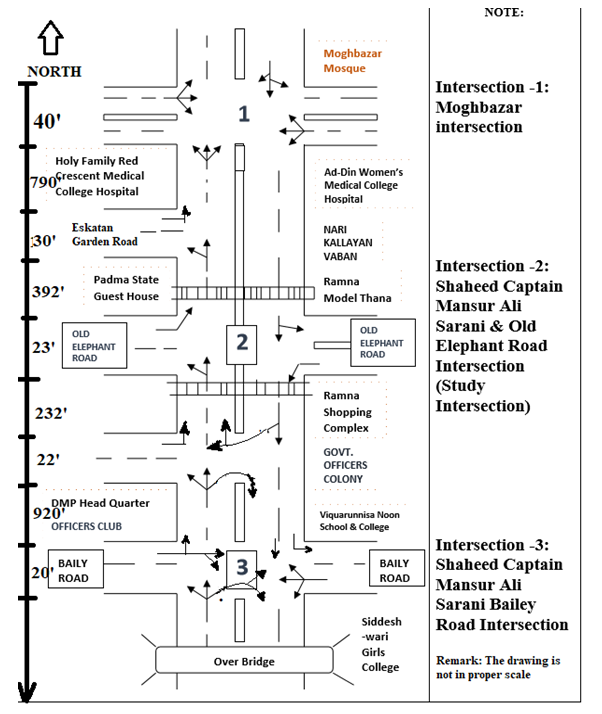 | Figure 1. A segment of SCMAS with study intersection (e.g., SCMAS & OER Intersection) |
No public bus operates on SCMAS except government, corporate and chartered buses. Though officially not permitted, however, due to lack of enforcement rickshaws (a non-motorized three wheeler) also ply on SCMAS. Traffic volumes on this roadway have been increased significantly in recent years due to a direct connection of Moghbazar-Mouchak Flyover (MMF) (See Figure 2) with SCMAS in March 2016. 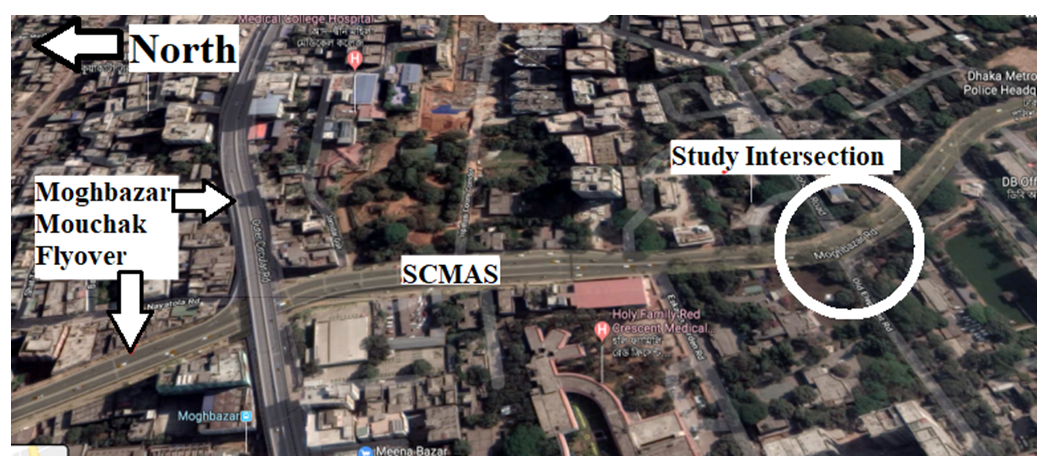 | Figure 2. SCMAS and MMF (Source: Google Map) |
The SCMAS and Old Elephant Road (OER) intersection (study intersection) is a major un-signalized intersection that facilitates pedestrian crossings on SCMAS. It is located at the heart of the city and the area contains a large number of educational institutions, government offices, hospitals and high-rise residential and commercial buildings. Before implementation of MMF, the intersection of SCMAS and Old Elephant Road (OER) was a signalized intersection permitting cross traffic through the intersection. However, it is now an un-signalized intersection and permits no through traffic from OER (see Fig. 1). The intersection permits pedestrian to cross SCMAS through its two designated crosswalks. The intersection is accessible by Rickshaws (a non-motorized mode also called three wheeler) via OER. However, the Rickshaw riders/passengers must cross SCMAS by walk to continue their trips on OER. Due to high volume of traffic on SCMAS, it is not only difficult for the pedestrians to cross SCMAS at the study intersection but also vehicular and pedestrian conflicts significantly deteriorate traffic operations on SCMAS, particularly causing congestion in the south bound direction. The purposes of this study are to:1. Investigate the pedestrian crossing problems (e.g., safety and crossing delay) at SCMAS and OER intersection and associated traffic operations problems (e.g., operating seed) on SCMAS. 2. Provide a compromised solution to both pedestrian crossing and traffic operations problems on SCMAS.
2. Literature Review
In this section, relevant literatures are reviewed. According to World Health Organization [3] Pedestrians, cyclists, and motorcyclists are vulnerable road users constituting nearly half the victims of road traffic accidents worldwide. As reported, 22% of the victims are pedestrians of which almost 35% are children. The roads of Dhaka city are very dangerous for pedestrians due to several reasons including reckless driving, inadequate footpaths, foot-over-bridges and crossing facilities, and pedestrians’ apathy towards making use of the existing foot-over-bridges. Inappropriate placement of foot-over-bridge and lack of zebra crossing are also a reason for pedestrian accident [4]. Rubayet and Sultana [5] observed the behavior of pedestrian at five different locations in Dhaka city. They found that more than 50% of the pedestrians are unwilling to use foot-over-bridge.Hasinae-Jannat [6] found that intersection crossings in Dhaka city are generally very poor with about 70 percent of the intersections having no formal crosswalks and about 73 percent of the intersections have no foot-over-bridge or underpass. Also where formal crossing facilities do exist, people do not properly utilize them [6,7]. In a separate study, Bhuiyan [8] found that foot-over-bridge is a better option as compared to crosswalks at intersections with heavy vehicular movements.Pervaz, Rabbi, and Newaz [9] reported that pedestrian accident is a growing problem in Dhaka city. The reasons for pedestrian accidents include inadequate and poor pedestrian crossing facilities and lack of priority for pedestrian infrastructure and facility improvements. Furthermore, sharing of heterogeneous traffic on same roadways and resulting speed variations make the pedestrian crossing more difficult. They also indicated that driver and pedestrian education is needed to improve pedestrian safety.A study conducted by the Accident Research Institute (Bangladesh University of Engineering and Technology) has shown that a total of 307 road accidents took place between 2009-2015 at 54 intersections in Dhaka city, where 198 people died and 103 injured. Engineering errors in road construction and lack of awareness has also shown as the primary reason for accidents. It is to mention here that the police grossly underreport the crashes in Bangladesh and the authority maintains site specific historical crash record (database) very poorly. Zafri, Rony, and Adri [10] conducted a study on pedestrian crossing speed and waiting time at selected intersections in Dhaka city with a focus of improving pedestrian safety. In that study, average pedestrian crossing speed is found to be 1.26 m/s. It is reported that the pedestrian walking speed and waiting time depends on factors including intersection control type, gender, age, and gap availability. Among the factors, intersection control type significantly influence the pedestrian waiting time at intersections. They also found that intersection crossing delay is more at locations where police manually control it as compared to signalized and un-signalized intersections. The speed of the pedestrians negatively correlates with the levels of vehicular flow. Gridlock is a common phenomenon on roads of Dhaka. Martin [11] has indicated that the Dhaka lacks mass transit system and freeways. During congested hours, it may take two to three hours to travel 15 km by auto-rickshaw. Khan and Haque [12] indicated that Dhaka roadways are heavily congested throughout the day causing stop-and-go conditions. They indicated that public buses are the primary contributor to congestion problems followed by cars.
3. Methodology
The study methodology includes: (1) reconnaissance survey and filed observations, (2) traffic and pedestrian data collections, and (3) pedestrian opinion survey.
3.1. Reconnaissance Survey and Field Observations
In order to better understand the pedestrian crossing and traffic operations problems, several field visits were made. During the field visits, pedestrian crossing behaviors and traffic flow characteristics were observed and recorded as video and image files. Major findings during the field observations include: pedestrians behave unpredictably and take high risk to cross SCMAS. Pedestrian crossing movements significantly interrupt the traffic flow on SCMAS causing stop-and-go conditions specifically in the southbound direction. It was also found that SCMAS operates as a 3-lane roadway (each direction) at the study intersection despite officially it is a 2-lane roadway (See Figure 3). The speed limit on SCMAS was found to be 30 km/hr.  | Figure 3. Vehicular and pedestrian conflicts on SCMAS crosswalks at the study intersection (SCMAS and OER) |
3.2. Traffic and Pedestrian Data Collections
The vehicular and pedestrian data were collected concurrently during three consecutive weekdays in mid August 2019 and the data include: √ Vehicular counts including intersection turning movements and vehicle classification counts√ Travel time surveys/speed surveys on SCMAS√ Pedestrian counts including pedestrian crossing volumes on SCMAS and the category (age-groups) of pedestrians √ Pedestrian delays on intersection corners (sidewalk) and pedestrian walking times/speeds on SCMAS crosswalks at the study intersectionTable 1 shows 3-day average vehicular volumes (count data) representing AM/morning (7 am - 10 am), MD/midday (12 pm - 3 pm), and PM/evening (5 pm - 8 pm) peak periods and Figure 4 shows the alphabetical notations used to designate the vehicular turning movements. As shown in the table, vehicular volumes during all three peak periods are found be very high, particularly highest volume is observed in the MD peak hour (e.g., between 12PM-1AM) making it as the worst hour for southbound vehicular traffic. The MD peak hour balanced volumes on SCMAS (including MMF and local road volumes) are shown in Figure 5.Table 1. Average Hourly Vehicular Volumes (veh/h)
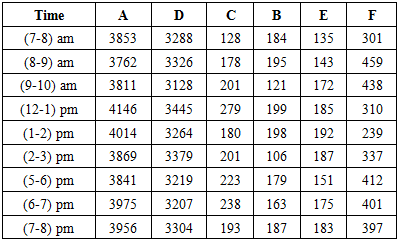 |
| |
|
 | Figure 4. SCMAS and OER intersection showing the notation of turning movements |
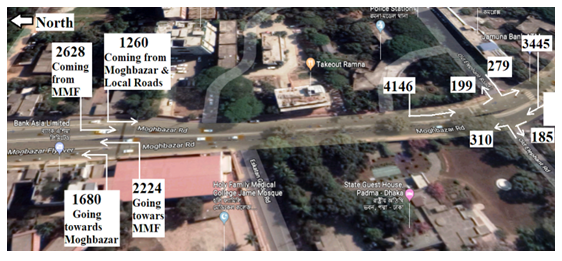 | Figure 5. Midday peak hour volumes on SCMAS showing MMF and local road split (Source: Google Map) (source: Google Map) |
Vehicle Classification data were also collected at the study intersection and are shown in Figure 6. The classification counts include car, motor bike, CNG, heavy vehicle and non-motorized vehicles. It is found that private car (auto), motor-cycle and CNG (a motorized three-wheeler) are the dominant modes of traffic on both the directions of SCMAS. However, motor bike, motorized and non-motorized 3-wheelers are also present substantially.  | Figure 6. Vehicular distributions by classification (AM, MD, and PM) on SCMAS |
Travel time surveys were conducted along north and southbound directions of SCMAS during the AM, MD, and PM peak hours by utilizing the floating car technique [13]. The survey routes (both northbound and southbound) are shown in Figure 7. Northbound travel time survey route begins at Dhaka Metropolitan (DMP) head quarter and ends at Dhaka Polytechnic Institute. While southbound survey route begins at Tejgaon on-ramp/entry point and ends at DMP headquarter. | Figure 7. North and southbound travel time survey routes on SCMAS (Source: Google Map) |
A total of 36 travel time runs (12 runs in each of the three peak hours) were performed in each direction. The detailed travel time survey results are shown in Table -2. It is found that the southbound traffic on SCMAS has been congested during all three peak hours. However, northbound traffic operates at a fairly good operating speed while maintaining relatively a lower vehicular volume level. The primary reason for stop and go conditions in the south bound direction is due to the fact that vehicles and pedestrians conflict on SCMAS crosswalks at the study intersection (see Figure 3). Table 2. Summary of travel time/speed survey on SCMAS
 |
| |
|
Pedestrian crossing volumes and age group (categorization) data were also collected during the AM, MD, PM periods and are summarized in Table 3 (see Figure 4 for crosswalk notations) and Fig. 8, respectively. The age groups were selected considering that children aged below 13 years and adult aged above 60 could face difficulty to use the foot over bridge. Furthermore, the tendency to violate traffic rules also depends on the age group. Young people intend to violate the rules more frequently than the older ones [6] and pedestrian age group (categorization) is needed to provide a suitable road crossing solution.Table 3. Pedestrian volumes on crosswalks (ped/h)
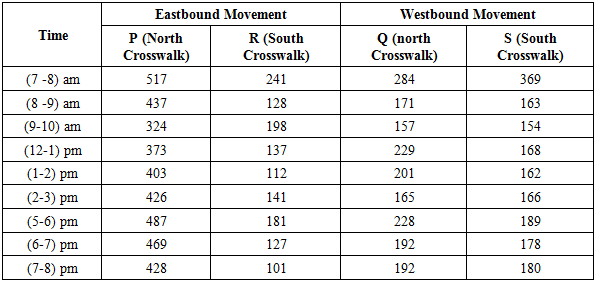 |
| |
|
 | Figure 8. Distribution of pedestrians by age-group (category) |
Pedestrian crossing volumes are found to be very high during all three peak hours. For instance, during 7AM-8AM, total pedestrian crossing volume on SCMAS (considering both crossing locations) is found to be 1411 pedestrian/hr. It is also found that the majority of the pedestrians are young pedestrian aged between 13-year and 60-year (e.g., 71%, 73%, and 82% in the AM, MD, and PM peak hours, respectively) followed by child pedestrian aged below 13 years (see Figure 8).In the morning (AM), a total of 310 children were observed, which accounts for 22% of the total pedestrians and this number decreases further in the MD and PM hours representing at 20% and 10%, respectively. The number of older pedestrians in the morning is 99 which accounts for 7% of he total pedestrians and; in the MD and PM peak hours their shares are approximately 7% and 8%, respectively.Pedestrians delay at the intersection corners (sidewalks) and walking time on crosswalks were studied to measure the performance of sidewalks. It is found that the pedestrians need to spend substential amount of time waiting at the intersection corners (sidewalks) and maintain overall poor walking speeds (e.g., the crossing speeds in the AM, MD, and PM peak hours are found to be 0.62, 0.47 and 0.35 meter per second, respectively) on crosswalks in all three peak hours (see. Table 4). It is to mention here that the standard pedestrain crossing speed for signal design purpose is considered to be 1.22 meter/ second (or 4-ft/s) [13]. The main resons for poor pedestrian crossing speeds include (1) finding a safe crossing gap is very difficult, (2) frequent pedestrian and vehicular conflicts substentially slow down pedestrian movements on crosswalks, and (3) lack of wide refuse island on the median further increases the safety risk and crossing delay time (see Figure 9). Table 4. Pedestrian waiting and crossing times
 |
| |
|
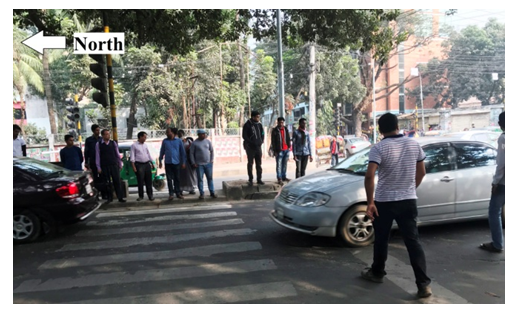 | Figure 9. Pedestrians on SCMAS crosswalks at the study intersection |
3.3. Pedestrian Opinion Survey
Pedestrian opinion surveys were conducted during the morning and evening peak hours based on a pre-selected set of questionnaires and the findings are shown in Figure 10. A total of 100 respondents were randomly selected representing both male and female pedestrians. The age group includes 80% young (age between 13-year and 60-year), 10% adult (age above 60) and the remaining 10% child pedestrians (age below 13). There were three key questions in the survey form as listed: (1) frequency of daily crosswalk use, (2) perception about the crossing risk (safety), and (3) preferred solution to the crossing problem. Regarding the frequency of cross walk use, it is found that 20-percent of the pedestrians uses the cross walk once a day, 50-percent uses twice a day and the remaining 30-percent uses more than twice a day. Majority (89%) of the pedestrians indicated that the crosswalks are very dangerous. Rest (11%) of the pedestrians indicated that the crosswalks are dangerous. None of them feel that the crosswalks are safe. Regarding the solution to the problem, 76-percent of the respondents prefer to install a foot-over-pass while 12-percent wants underpass. The remaining respondents (12%) prefer some form of at-grade solutions such as reinstating the traffic/pedestrian signal.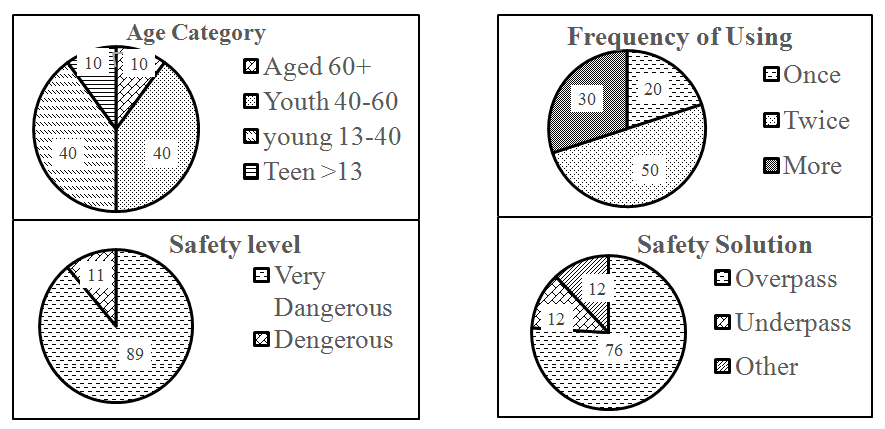 | Figure 10. Pedestrian opinion survey findings |
4. Conclusions and Recommendations
The study intersection (SCMAS and OER) is found to be the critical intersection from both vehicular operations and pedestrian crossing movement perspective. Heavy pedestrian crossing volumes along with heavy vehicular volumes results in poor operations of SCMAS. The study reveals that southbound movement of SCMAS is heavily congested due to the un-signalized intersection crossings. Furthermore, pedestrians find it extremely difficult to cross SCMAS with multiple moving lanes in each direction. Furthermore it is found that there is no midblock refuse island for pedestrians to safety cross the road. Travel time study also reveals that average operating speed of SCMAS is below 6 km/hr. Re-instating the traffic signal may improve the pedestrian safety on crosswalks. However, it will not be beneficial for traffic operations improvements on SCMAS. Thus, it is concluded that without grade separated pedestrian crossings, it is not possible to ensure safe pedestrian crossings. Given the right-of-way restriction and heavy rain fall in Dhaka city during the monsoon period, it is not suitable to provide an underpass for pedestrian crossing purpose. Furthermore, pedestrian opinion survey indicates that the pedestrian foot-over-bridge would be a desirable solution not only for safe pedestrian crossings but also for improving the traffic flow on SCMAS. However, conventional overpass (foot over bridge) is not suitable for children and older pedestrians. Therefore, an overpass with an elevator service is recommended.
ACKNOWLEDGEMENTS
The authors would like to acknowledge the support of the following DCEE students of North South University in the the data collection efforts: Anik Kumar Bhakta, Raihanul Haque, Muneem Shahbuddin, Sameer Dash, Md.Rafiq, and Ishmaam Md. Arif Aktab. The gratitude also goes to the Ramna Model Thana authority for granting permission to conduct this study.
References
| [1] | Chowdhury M. S. (2014). Sustainable Transportation Systems for Dhaka Metropolitan City: Issues and Opportunities, ICSI-2014, pp. 448-459, ASCE, ISBN: 9780784478745. |
| [2] | Bird, J., Li, Y., Rahman, Z., Rama, M., & Venables, A. (2018). Toward Great Dhaka: A New Urban Development Paradigm Eastward. World Bank Group. Retrieved October 10, 2019, from http://hdl.handle.net/10986/29925. |
| [3] | World Health Organization (WHO). (2011). Global Plan for the Decade of Action for Road Safety 2011-2020, Genevan27, Switzerland. |
| [4] | Nawaz, F. (2017). Dhaka’s intersections: A death trap. Dhaka: Kazi Anis Ahmed. Retrieved 10 9, 2019, from https://www.dhakatribune.com/bangladesh/dhaka/2017/10/21/dhakas-intersections-death-trap. |
| [5] | Rubayat, A., & Sultana, N. (2013, 7). Reasons Behind The Road-Traffic Accident In Dhaka City: An Empirical Study. Impact: International Journal of Research in Humanities, Arts and Literature (IMPACT: IJRHAL ), 1(2), 47-56. Retrieved October 10, 2019, from http://paper.researchbib.com/view/paper/6792. |
| [6] | Hasinae-Jannat, (2013). Pedestrian Road Crossing Behavior At Signalised Intersections And Mid Block Sections In Dhaka City (unpublished master’s thesis). Bangladesh University of Engineering & Technology, Dhaka, Bangladesh. Retrieved from https://0x9.me/rEi4W. |
| [7] | Aminuzzaman, S. M. And Shuvo, S. H., Culture of Defying Laws: A Case Study on ‘Foot Over bridges’ in Dhaka City, Outcome of Group 1, Department of Public Administration, University of Dhaka, Dhaka, 2015. |
| [8] | Bhuiyan, N. F. (2019). Enhancing Pedestrian Safety in Bangladesh. 1st Convention of NRB Engineers, 26-27 February, 2019. Retrieved December 1, 2019, from https://www.researchgate.net/publication/332057524_Enhancing_Pedestrian_Safety_In_Bangladesh. |
| [9] | Pervaz, S., Rabbi, S. H.-E., & Newaz, M. K. (2016). Pedestrian Safety At Intersections In Dhaka Metropolitan City. 17th International Conference Road Safety On Five Continents (RS5C 2016). Rio de Janeiro. Retrieved October 09, 2019, from https://www.researchgate.net/publication/319112532. |
| [10] | Zafri, N. M., Rony, A. I., & Adri, N. (2019, july 2). Analysis of Pedestrian Crossing Speed and Waiting Time at Intersections in Dhaka. Infrastructure, 4(3). doi:10.3390/infrastructures4030039. |
| [11] | Martin, J. (2012, October 01). 10 monster traffic jams from around the world. Retrieved 10 09, 2019, from BBC News Magazine: https://www.bbc.com/news/magazine-19716687. |
| [12] | Khan, S. M., & Haque, M. S. (2013, July). Traffic Flow Interruptions in Dhaka City: Is Smooth Traffic Flow Possible? Journal of Presidency University, 2(2), 46-54. Retrieved October 09, 2019, from http://presidency.edu.bd/uploads/Article007.pdf. |
| [13] | Roess R. P., McShane W. R., and Prassas E. S (2011). Traffic Engineering, Fourth Edition, Prentice Hall. |













 Abstract
Abstract Reference
Reference Full-Text PDF
Full-Text PDF Full-text HTML
Full-text HTML


